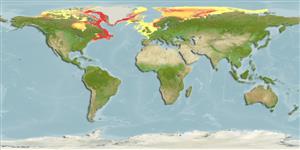Environment: milieu / climate zone / depth range / distribution range
Écologie
marin bathydémersal; profondeur 18 - 930 m (Ref. 117245). Deep-water; -1°C - 4°C (Ref. 13534); 83°N - 41°N, 139°W - 141°E (Ref. 117245)
Western Atlantic: western Greenland (Ref. 4695), Hudson Bay and Labrador to Massachusetts (Ref. 7251). Arctic: west of Boothia Peninsula in the Northwest Territories (Ref. 3814) and the northern parts of Kara and Laptev seas (Ref. 4695).
Taille / Poids / Âge
Maturity: Lm ? range ? - ? cm
Max length : 36.0 cm TL mâle / non sexé; (Ref. 7251)
Occurs on soft bottoms (Ref. 13534). Benthic (Ref. 58426). Feeds mainly on epibenthic animals and does not seem to burrow much for prey. Smaller fish prey on smaller species like amphipods, isopods and small bivalves while larger fish prey on shrimps, euphausiids and fish (Ref. 13532).
Life cycle and mating behavior
Maturité | Reproduction | Frai | Œufs | Fécondité | Larves
Anderson, M.E., 1994. Systematics and osteology of the Zoarcidae (Teleostei: Perciformes). Ichthyol. Bull. J.L.B. Smith Inst. Ichthyol. 60:120 p. (Ref. 11954)
Statut dans la liste rouge de l'IUCN (Ref. 130435: Version 2024-1)
Menace pour l'homme
Harmless
Utilisations par l'homme
Outils
Articles particuliers
Télécharger en XML
Sources Internet
Estimates based on models
Preferred temperature (Ref.
123201): 1.4 - 7.1, mean 3.5 °C (based on 213 cells).
Phylogenetic diversity index (Ref.
82804): PD
50 = 0.5000 [Uniqueness, from 0.5 = low to 2.0 = high].
Bayesian length-weight: a=0.00309 (0.00192 - 0.00496), b=3.21 (3.07 - 3.35), in cm total length, based on LWR estimates for this species & Genus-body shape (Ref.
93245).
Niveau trophique (Ref.
69278): 3.5 ±0.53 se; based on food items.
Résilience (Ref.
120179): Faible, temps minimum de doublement de population : 4,5 à 14 années (Preliminary K or Fecundity.).
Fishing Vulnerability (Ref.
59153): Low to moderate vulnerability (26 of 100).
